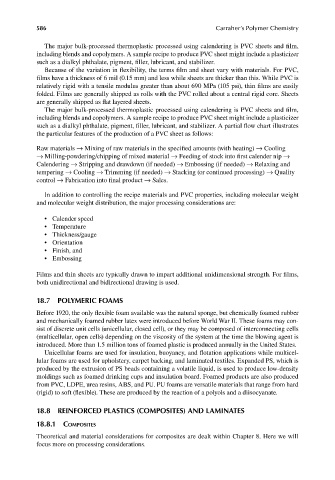Page 623 - Carrahers_Polymer_Chemistry,_Eighth_Edition
P. 623
586 Carraher’s Polymer Chemistry
The major bulk-processed thermoplastic processed using calendering is PVC sheets and fi lm,
including blends and copolymers. A sample recipe to produce PVC sheet might include a plasticizer
such as a dialkyl phthalate, pigment, filler, lubricant, and stabilizer.
Because of the variation in flexibility, the terms film and sheet vary with materials. For PVC,
films have a thickness of 6 mil (0.15 mm) and less while sheets are thicker than this. While PVC is
relatively rigid with a tensile modulus greater than about 690 MPa (105 psi), thin films are easily
folded. Films are generally shipped as rolls with the PVC rolled about a central rigid core. Sheets
are generally shipped as flat layered sheets.
The major bulk-processed thermoplastic processed using calendering is PVC sheets and fi lm,
including blends and copolymers. A sample recipe to produce PVC sheet might include a plasticizer
such as a dialkyl phthalate, pigment, filler, lubricant, and stabilizer. A partial fl ow chart illustrates
the particular features of the production of a PVC sheet as follows:
Raw materials → Mixing of raw materials in the specified amounts (with heating) → Cooling
→ Milling-powdering/chipping of mixed material → Feeding of stock into first calender nip →
Calendering → Stripping and drawdown (if needed) → Embossing (if needed) → Relaxing and
tempering → Cooling → Trimming (if needed) → Stacking (or continued processing) → Quality
control → Fabrication into fi nal product → Sales.
In addition to controlling the recipe materials and PVC properties, including molecular weight
and molecular weight distribution, the major processing considerations are:
• Calender speed
• Temperature
• Thickness/gauge
• Orientation
• Finish, and
• Embossing
Films and thin sheets are typically drawn to impart additional unidimensional strength. For fi lms,
both unidirectional and bidirectional drawing is used.
18.7 POLYMERIC FOAMS
Before 1920, the only flexible foam available was the natural sponge, but chemically foamed rubber
and mechanically foamed rubber latex were introduced before World War II. These foams may con-
sist of discrete unit cells (unicellular, closed cell), or they may be composed of interconnecting cells
(multicellular, open cells) depending on the viscosity of the system at the time the blowing agent is
introduced. More than 1.5 million tons of foamed plastic is produced annually in the United States.
Unicellular foams are used for insulation, buoyancy, and flotation applications while multicel-
lular foams are used for upholstery, carpet backing, and laminated textiles. Expanded PS, which is
produced by the extrusion of PS beads containing a volatile liquid, is used to produce low-density
moldings such as foamed drinking cups and insulation board. Foamed products are also produced
from PVC, LDPE, urea resins, ABS, and PU. PU foams are versatile materials that range from hard
(rigid) to soft (flexible). These are produced by the reaction of a polyols and a diisocyanate.
18.8 REINFORCED PLASTICS (COMPOSITES) AND LAMINATES
18.8.1 COMPOSITES
Theoretical and material considerations for composites are dealt within Chapter 8. Here we will
focus more on processing considerations.
9/14/2010 3:43:38 PM
K10478.indb 586 9/14/2010 3:43:38 PM
K10478.indb 586

